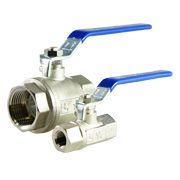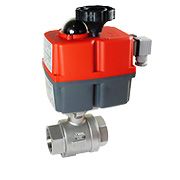Shut-off ball valves
Ball valves, as elements of industrial installations, are used to shut off, open or control liquid or gaseous media. They are perhaps the most widely used type of valve, and have almost completely replaced the once widely used poppet valves in many applications.
The construction of the ball valve is very simple, namely the valve consists of a body and a ball with a through-hole, which controls the flow direction.
The ball is made of chrome-plated brass or stainless steel. The movement of the ball is controlled by a spindle, which is most often ended with a lever or a butterfly handle.
The body is most often made of brass or stainless steel, but also of plastic or carbon steel. This allows the valves to be used in a variety of working conditions and environments.
Ball valves most often have BSP threaded or flanged connections. An important element is the type of seal, which is selected depending on the type of medium, temperature and working pressure.
The most common sealing in ball valves is PTFE, VITON, NBR.
Ball valves, types and types
- Pneumatically operated ball valves
Valves of this type are made of brass or stainless steel, have a plate for mounting a pneumatic drive (rotary actuator) and also have a manual lever.
To fasten the actuator, remove the lever and integrate the valve with the rotary actuator using four screws.
- Connections from 1/2 "to 3"
- Body: CF8M stainless steel
- Ball: CF8M stainless steel
- Stem: AISI 316 acid resistant steel
- Seals: Teflon
- Temperature range: -10 ° C to 180 ° C
- Medium: water, oils, inert gases, other liquids.
Three-way pneumatic ball valve
Valves of this type (also called three-way) belong to the group of valves that control the flow direction of the working medium and are intended for liquid and gaseous media. This goal is achieved by appropriately combining the valve paths.
Due to their functions, they can be in the L or T system. This is done by a ball with holes in the L or T system.
The pattern of L-roads is a separating function and the pattern of T is a hash function. The versatility of application makes the three-way valves can be successfully used in industry as well as in domestic solutions.
They are used for such media as:
- compressed air
- technical gases
- oxygen
- hydraulic fluids
- natural gas
- water
- heating and cooling factors
Three-way ball valves can be equipped with threaded, flanged or welded connections.
They are made of brass, stainless steel, carbon steel or plastic. Most often they have manual control (lever), but pneumatic (pneumatic drives) or electrically controlled are also available.
Ball check valves
Check valves are elements of fittings, they are used where the medium flow is required only in one direction, which is why they are often called one-way valves.
Check valves are designed to prevent reverse flow, i.e. backflow of the working medium in the installation (usually by means of a spring and a ball). They protect pneumatic installations against harmful backflow of the working medium. They are also used in pneumatic logic systems.
Each check valve has an opening pressure or a pressure difference amount. Both criteria are important when selecting for a specific application. The check valves are selected for the system taking into account the flow rate and the opening pressure.
Check valves are most often made of brass, stainless steel or plastic, with threaded or plug connections. They are used in pneumatic, hydraulic and water CO installations as well as for other liquid and gaseous media.
Versions for operation with high media pressures, even up to 350 bar, are also available.
Tapping ball valves
Valves of this type are in the form of a tap and are used for filling various vessels (i.e. emptying tanks, barrels, IBC containers) or for connecting a hose at the end of the installation. Used for media such as:
- Potable water,
- technical water,
- oils,
- liquid chemicals,
- liquid foods,
- drinks etc.
The intake valves are controlled manually with a lever. They are also used in conjunction with a garden hose, which is used in gardening or domestic use. They are usually made of brass as well as plastic or stainless steel and belong to the group of valves controlling the flow direction and fulfill 2/2 functions.
The main task of the draw-off valves is to close and open the flow of the working medium.
Ball valves with LOCKOUT system
A group of ball valves with a higher safety standard, in which mechanical interlocks secured with a padlock are used. This system protects the ball valve against unauthorized control or against broadly understood human errors.
This provides protection for maintenance workers, machine operators, and various industrial installations.
Pneumatically controlled valves (with pneumatic drive) offer
They are based on the operation of actuators which, after receiving the appropriate signal, change the position of the valve. Both ball valves with electric and pneumatic actuator are made of stainless and acid-resistant steel.
In addition, they are sealed with Teflon, thanks to which they can work with a medium whose temperature exceeds 180 ° C and a pressure of 60 bar.





Login and Registration Form